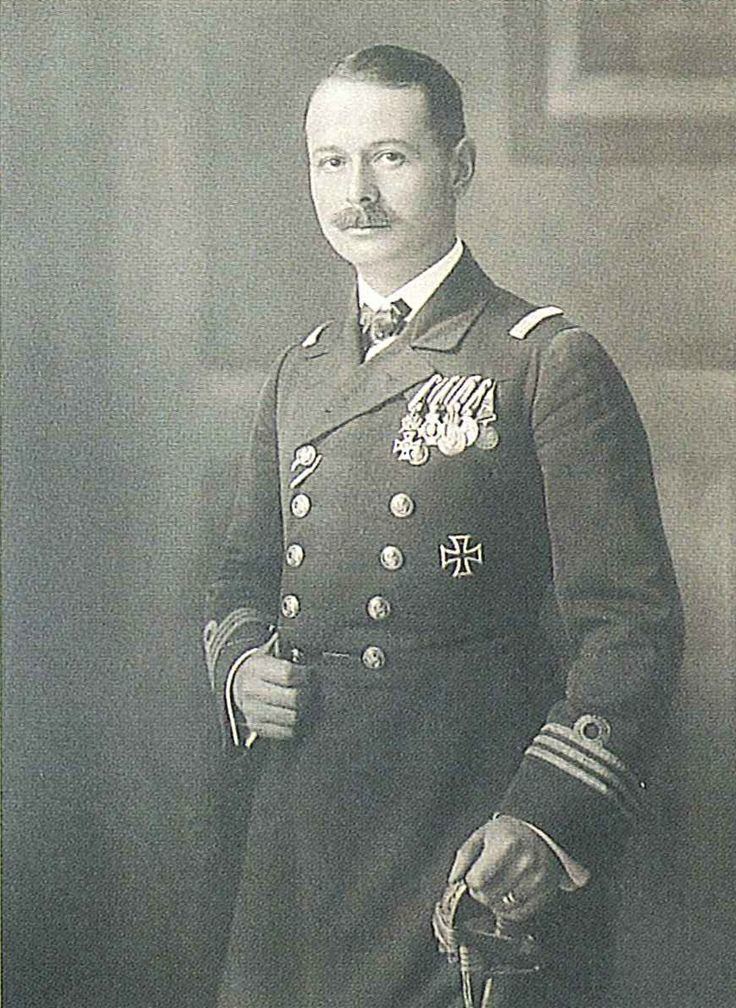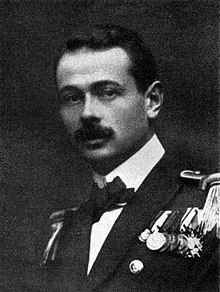Nationality Austrian; Italian Name Georg Trapp Books To the last salute | Religion Roman Catholicism Years of service 1898–1918 | |
 | ||
Born 4 April 1880 ( 1880-04-04 ) Allegiance Austro-Hungarian Empire (to 1918) Rank Corvette Captain (Lieutenant-Commander) Children Agathe von Trapp, Maria Franziska von Trapp Parents Hedwig Wepler, August Ritter von Trapp Similar People Maria von Trapp, Agathe von Trapp, Maria Franziska von Trapp, Christopher Plummer, Johannes von Trapp | ||
Drafting - Poetry - Georg von Trapp I OUT OF THE TRENCHES
Corvette Captain Georg Johannes, Ritter von Trapp (4 April 1880 – 30 May 1947), often incorrectly referred to as Baron (Freiherr) von Trapp, was an Austro-Hungarian Navy officer. His naval exploits during World War I earned him numerous decorations, including the prestigious Military Order of Maria Theresa. Under his command, the submarines SM U-5 and SM U-14 sank 13 Allied ships totaling about 45,669 gross register tons (GRT).
Contents
- Drafting Poetry Georg von Trapp I OUT OF THE TRENCHES
- Georg von Trapp Shattered
- Early life
- Naval career
- Italian citizenship
- First marriage
- Second marriage
- Departure from Austria and later life
- Death
- Orders decorations and medals
- References

Following Austria-Hungary's defeat and subsequent collapse, Trapp returned to his family but lost his first wife to scarlet fever, in 1922. Five years later, Trapp married his children's tutor Maria Augusta Kutschera, who trained the children to perform at various events as a way of earning a livelihood after most of the family's wealth was wiped out in a failed banking venture. The family came under increasing persecution from the Nazis after the Anschluss, when Trapp refused to serve in the German Navy due to his opposition to Nazi ideology. Fearing arrest, Trapp fled with his family to Italy and then to the United States, where he set up a farm and lived the remainder of his life there until his death in 1947. The story of his family served as the inspiration for the musical The Sound of Music (1959) and the 1965 film.

Georg von Trapp - Shattered
Early life
Georg Johannes Ritter von Trapp (4 April 1880 – 30 May 1947) was born in Zara, Dalmatia, then a Crown Land of the Austro-Hungarian Empire (present-day Zadar, Croatia). His father, Fregattenkapitan August Trapp, was a naval officer who had been elevated to the Austrian nobility in 1876, which entitled him and his descendants to the style of "Ritter von Trapp" for sons and "von Trapp" for daughters. A Ritter (knight) is a hereditary title of nobility roughly equivalent to a British baronetcy, which is a hereditary knighthood but does not confer nobility. In the Austrian order of precedence Ritter ranked above the lowest rank of the nobility, Edler (nobleman), and below a Freiherr (baron), a Graf (count), and "Furst," (prince) (Herzog, or duke, was reserved for agnates of the imperial family). Georg's mother was Hedwig Wepler. His older sister was the Austrian artist Hede von Trapp, and his brother Werner died in 1915 during the First World War.
August Ritter von Trapp died in 1884, when Georg was four.
Naval career
In 1894, aged fourteen, the young Trapp followed in his father's footsteps and joined the Imperial and Royal Austro-Hungarian Navy, entering the naval academy at Fiume (now Rijeka). He graduated four years later and completed two years of follow-on training voyages, including one to Australia. On the voyage home he visited the Holy Land where he met a Franciscan monk who took him on a tour of all the Biblical sites he wanted to see. Among other things, Trapp bought seven bottles of water from the Jordan River which were later used to baptize his first seven children. In 1900 he was assigned to the armored cruiser SMS Kaiserin und Konigin Maria Theresia and was decorated for his performance during the Boxer Rebellion. In 1902 he passed the final officer's examination. He was fascinated by submarines, and in 1908 seized the opportunity to be transferred to the navy's newly formed submarine arm, or U-boot-Waffe. In 1910 he was given command of the newly constructed SM U-6, which was launched by his wife, the former Agatha Whitehead. He commanded U-6 until 1913.
On 17 April 1915, Trapp took command of SM U-5 and conducted nine combat patrols. While in command of SM U-5 he sank two enemy warships:
He also captured the Greek steamer Cefalonia off Durazzo on 29 August 1915.
Georg Johannes von Trapp has sometimes incorrectly been credited with sinking the Italian troop transport Principe Umberto. In reality, this was sunk by U-5 under Trapp's successor Friedrich Schlosser (1885–1959) on 8 June 1916, after Trapp was transferred to the SM U-14 which had previously been the French submarine Curie, before it was sunk and salvaged by the Austrian Navy.
Trapp conducted ten more war patrols, until, in May 1918, he was promoted to Korvettenkapitan (equal to Lieutenant commander) and given command of the submarine base in the Gulf of Kotor. At the end of the fighting in 1918, Trapp's wartime record stood at 19 war patrols; 11 cargo vessels totalling 45,669 GRT sunk, plus the Leon Gambetta and Nereide and 1 cargo vessel captured. Among other honours, he received the Knight's Cross of the Military Order of Maria Theresa. The end of the First World War saw the defeat and collapse of the Austro-Hungarian Empire. In the process, Austria was reduced in size to its land-locked German-speaking heartlands, thus losing its sea-coasts, and had no further need for a navy, leaving Trapp without a vocation or employment.
Italian citizenship
After the First World War, Zara became a part of the Kingdom of Italy: Georg von Trapp, who was born in Zara, obtained Italian citizenship and so when he had to flee form Austria (in 1938), he could go to Italy as an Italian citizen.
First marriage
Trapp was first married to Agatha Whitehead, a niece of St John Brodrick, 1st Earl of Midleton and a granddaughter of Robert Whitehead, who invented the modern torpedo. After the British government had rejected Whitehead's invention, the Austrian Emperor Franz Josef invited him to open a torpedo factory in Fiume (present-day Rijeka, Croatia). Trapp's first command, the U-boat U-6, was launched by Agatha.
Agatha's inherited wealth sustained the couple and permitted them to start a family, and they went on to have seven children; two sons and five daughters, over the next ten years. Their first child, Rupert, was born on 1 November 1911, at Pola, Istria, while the couple was living at Pina Budicina 11. The marriage produced six more children: Agathe, also born at Pola; Maria Franziska; Werner; Hedwig; and Johanna; all born at Zell am See, at the family home, the Erlhof. and Martina, born at Klosterneuburg at the family home, the Martinsschlossel, for which she was named.
On 3 September 1922, Agatha von Trapp died of scarlet fever contracted from her daughter Agathe. Trapp then acquired a villa in Aigen, a suburb of Salzburg, and moved his family there in 1924.
Second marriage
About 1926, Maria Franziska was recovering from an illness and was unable to go to school, so Trapp hired Maria Augusta Kutschera, from the nearby Nonnberg Abbey, as a tutor.
At the age of 47, Trapp married Maria Augusta Kutschera, then aged 22, on 26 November 1927. They had three children: Rosemarie, born on 8 February, either 1928 or 1929, in Salzburg, Austria; Eleonore, born 14 May 1931, in Salzburg; and Johannes, born 17 January 1939, in Philadelphia, bringing the total number of the Trapp children to ten.
Departure from Austria and later life
In 1935, Trapp's money, inherited from his English first wife, was invested in a bank in England. Austria was under economic pressure from a hostile Germany, and Austrian banks were in a precarious position. Trapp sought to help a friend in the banking business, Auguste Caroline Lammer (1885–1937), so he withdrew most of his money from London and deposited it in an Austrian bank. The bank failed, wiping out most of the family's substantial fortune.
Faced with an impossible situation of little or no money and a husband incapable of providing for her or for the family, Maria von Trapp took charge and began to make arrangements for the family to sing at various events as a way of earning a livelihood. At about that time, a Catholic priest, Franz Wasner, around Maria's age, came to live with them and became the group's musical director. Around 1936, Lotte Lehmann heard the family sing, and she suggested they perform paid concerts. When the Austrian Chancellor Kurt von Schuschnigg heard them on the radio, he invited them to perform in Vienna.
According to Maria von Trapp's memoirs, Georg von Trapp found himself in a vexing situation after the German takeover of Austria in 1938. He was offered a commission in the German Navy, a tempting proposition for a Captain without a navy, but decided to decline the offer, being opposed to Nazi ideology. Knowing that he could not decline the offer without the threat of arrest, possibly for his entire family, Trapp decided to leave Austria. The family took a train to Italy, then sailed to the United States for their first concert tour, then in 1939 went back to Europe to tour Scandinavia, hoping to continue their concerts in cities beyond the reach of the Third Reich. During this time, they went back to Salzburg for a few months before returning to Sweden to finish the tour. From there, they traveled to Norway to begin the trip back to the United States in September 1939.
After living for a short time in Merion, Pennsylvania, where they welcomed their youngest child, Johannes, the family settled in Stowe, Vermont, in 1941. They purchased a 660-acre (270 ha) farm in 1942 and converted it into the Trapp Family Lodge. In January 1947, Major General Harry J. Collins turned to the Trapp family in the USA pleading for help for the Austrian people, having seen firsthand the residents of Salzburg suffer when he had arrived there with the famed 42nd Rainbow Division after World War II. The Trapp Family founded the Trapp Family Austrian Relief, Inc., and the priest Franz Wasner, their pre-war friend, became its treasurer.
Death
Georg Johannes von Trapp died of lung cancer on 30 May 1947, in Stowe, Vermont.
